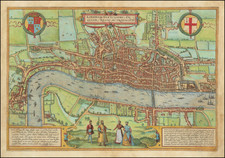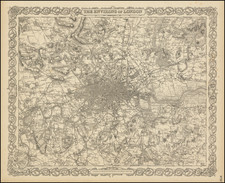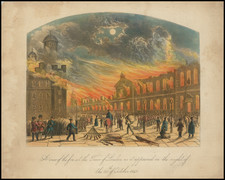One of the Best Bird's-Eye Views of London.
A handsome example of one of the great 17th-century views of London executed by the Prague-born master-engraver Wenceslaus Hollar.
The view is taken from roughly above Lambeth Palace, on the south bank of the Thames. It takes in much of built-up London north of the Thames, but one of the most charming aspects of the view is its treatment of the pastoral landscape south of the river. Along with Hollar's "Long View" of 1647, this is unquestionably one of the greatest images of the city from that period.
Hind (18) comments:
The view is taken from nearly above and behind Lambeth Palace. The river scarcely seen E. of Somerset House. Extent W., to Peterborough House (i.e. just short of Tothill Fields, which are included in the Long View of 1647).
Of particular interest as showing the fields on the S. side of the Thames.
This view is described by Parthey as London before the Fire, but I have only seen impressions showing the new St. Paul's Cathedral. These impressions all show what seems to be rework (coarsely done, and hardly by Hollar) on Sheets 3 and 4, and the town as rebuilt on the parts destroyed by the Fire. St. Paul's shows its dome, but only one of the W. Towers. The Monument is shown and a reference to the Monument (which was in building 1671-1677). It is dated 1674 in the Crace collection catalogue, but I do not know on what foundation
The two left sheets (1 and 2) show Hollar's work most purely. Unless Hollar left the other plates unfinished, one must expect to find impressions of the earlier state before the coarser rework. The plates of this subject descended to the eighteenth-century printseller Robert Sayer, and no doubt after him to his successors, Laurie and Whittle, so that late and reworked impressions are common. It was published in this late state with the impressions from each plate folded for binding.
Wenceslaus Hollar
Two features combine to make Hollar's work stand out among the great engravers of the 17th century: his sharp eye that captured a realistic view of objects, people, and places, and his wide travels, during which he made copious sketches that he later turned into engravings. Of the most important of his travels were those that he made to England, where he spent many years in the service of Lord Arundel, a great patron of the arts.
This period in England allowed Hollar the opportunity to travel extensively through the country and to produce a number of Anglo-centric engravings that are today among the most desirable of his output. This period was also a tumultuous one, with the English Civil War starting at the end of his tenure in the country. Having experienced the ruin of his own family following the Sack of Prague, the fate of his adopted country and his English patrons during the interregnum marked Hollar profoundly. Following the onset of conflict, Hollar returned to the Low Countries but continued to work on his English material. It was during this period, in Antwerp, that the Long View was produced.
Hollar continued to travel through his life and would return to England during the restoration. Yet, he never managed to again capture the success of his pre-Restoration period and would die in extreme poverty in 1677.
Dating and States
Pennington (1013) was able to discern states of the view, although neither he nor Hind were able to provide definitive dating of the states and substrates. Pennington does say that state ii was completed after 1697. Pennington and Hind suggest that in the late state the print was issued by Robert Sayer and his successor Laurie and Whittle. Based on the paper, the present example would seem to have been done circa 1760. Parthey was under the impression that the first state of the view was made before the Great Fire in 1666, though Hind questioned that. The British Museum dates the print to 1647, like so many of Hollar's other views of London.
From from left to right (1 - 4), Pendleton identifies the plates as second state, in part, by the appearance of:
- The phrase "Pendleton House" at the extreme left
- An outline view of Hamsted over Westminster
- The redesign of St. Paul's to resemble its actual, classical layout, although a tower has been omitted
- The addition of the Monument.













![[New and Exact Plan of the City’s of London and Westminster and the Borough of Southwark And the Additional New Buildings Churches &c to the present Year 1735.] (Western sheet]](https://storage.googleapis.com/raremaps/img/small/62521.jpg)
![Bartholomew's Plan of London [London Fire Brigade Instructional Map]](https://storage.googleapis.com/raremaps/img/small/72233.jpg)

